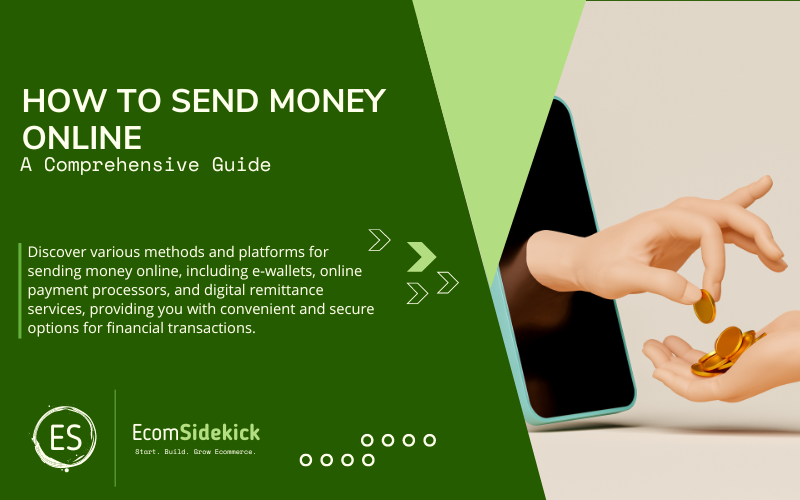International money transfers have always been a thing when it comes to doing business. But ever since the pandemic hit, with most of the workforce going remote, business offices have begun to rely on diverse delivery options for payments.
And that is before we even discuss how practical this can be for small businesses since it simplifies the process of paying team members who live abroad or are remote workers.

You probably found this article wanting to figure out another step in your entrepreneurship journey. As it begins, there will be a lot to figure out and not all of it has to be complicated. It is important to make meaningful choices when setting up foundational steps, such as which payment methods to use. You should look for cheaper transfers with a reliable company. But how to send money online?
There has been an undeniable boom in the online payment industry since 2020. It is a convenient option for both small transactions and safely sending more significant amounts of money. You usually need little more than an email address, a debit card, or a credit card; choose your preferred delivery method, and there you have it.
But here at EcomSidekick, we know simplicity can be deceiving. So follow along on this article to see the comprehensive guide on the online version of the money transfer process. Let’s start with the most important step, choosing which platform is the best for you.
How to Send Money Online: Top Platforms
There are many advantages when you choose to go with an online service, the biggest one probably being how much cheaper they are than bank wire transfers. However, along with an exponential industry growth came a number of different companies available for business. Each with its own particularities, so check out the main ones:
Wise
When it comes to having your money reach its destination in a single business day or less, Wise is the choice to go with. Formerly known as TrasnferWise, this platform has evolved from a simple international transfer service to an online banking platform.
As for the fees charged per transfer, this service charges a low fixed fee between $0.50 and $1.00. Along with that, there is a variable fee for the cost of currency exchange, usually 0.45% of the transaction total for major currencies.
With their website and mobile app being incredibly user-friendly, most people make this their one-stop for moving money around. This is a good option for both personal use and small business transactions.
Payoneer
After almost twenty years of service, Payoneer is quickly becoming a favorite transfer method among businesses with international partners. Although its delivery time can run a little longer than other places, there is one significant advantage to using it: its low fee system.
Exchange rates are usually fixed, so the difference between which place you go to is almost none. But when it comes to the charges on transfers, Payoneer charges you nothing on transactions if both parties have an account on the platform.
Unlike others, this isn’t an option accepted as payment in most places, so there will be a small fee to move the money into your bank account. That is $1.50 for the US and 2% of your transaction for non local currencies.
Their website is a little confusing to use if you’re not very tech-savvy, but the app more than makes up for it. It’s available for Android and iOS, so everyone who wants to save money can get started on it.
Western Union
If cash transfers were a high school, Western Union would be the veteran everyone goes to for homework help. Here the delivery speed will depend on the method, the one you pay for, and which you choose for delivery.
This company is special because it has the feature of cash pickup available. Yes, your partner will be able to walk into a store and get their money in a lot of places.
For such a reliable company, Western Union’s fee structure is so complex we could have a whole article dedicated to it.
Fees charged for your transfer itself are going to vary based on where you are, where your money is going, how much is moving, and even how it moves can influence it. These factors also have a hand in how long your money takes to get to its final destination.
Their foreign exchange rate is calculated based on something called the mid-market rate, which is an average of all the rates and doesn’t bring any real profit. Western Union will charge you up to 6% on your transfer to gain something.
While not the cheapest option, this is definitely one of the most accessible ones. Their user interface online is simple enough, and it has the added bonus of being able to go into a store or make a call to have an actual person help you as well.
So if you and tech don’t get along very well, this might be your best option.
PayPal
This is another company that could have its own article, given how many functionalities are available. Since its foundation in 1998, PayPal has become a widely accepted payment platform, especially for small businesses online.
When it comes to paying for goods, with either a debit card or credit card, money will be available to your platform balance almost instantly. It can be in your bank account fast too.
They don’t get much money from currency exchange since their fees are where it’s at. Depending on what you do with the platform, your fees will vary. But we are talking about moving your money internationally and the transfer costs.
With PayPal, there are two core fee structures: one for debit or credit card payments and another if you go with the online checkout process. For your card, it’ll be 2.99% plus $0.49; and if you opt to check out online, it’ll be 3.49% plus $0.49.
Whether through their own portal or the embedded option in other websites, PayPal can be a breeze to use. One of the few disadvantages is that it doesn’t have the same currency availability as other platforms out there.
World Remit
World Remit is the group’s baby, given how it was founded less than fifteen years ago. But what it lacks in age, it makes up by having no hidden costs and the flexibility of sending money to more than 130 countries.
This guy can send money to your recipients within minutes in most cases and less than twenty-four hours overall. Their app gives you several ways to deliver money. Your transactions can be completed by cash pickup, bank transfers, mobile money, home delivery, and others. And they can be started with payments that range from debit cards to mobile wallets, excluding google pay.
However, having no hidden costs means their fee structure is a little complex. We can already tell you that their standard fee is $3.99, which can go as low as $1.99 depending on the criteria your transfer fits into.
Most users rave about the easiness of using their app, available for Android and iOS, on top of their incredible security features. If you want a great combo of safety and reach, then maybe World Remit is the way to go.
Now that you have a better idea of which of the leading platforms is going to fit your needs, really consider how important it is to know your small business or if your main need is to pay remote workers or team members living abroad. Your choice may vary based on what you will do, but the signing-up process is going to look very similar, so let’s walk through that now.
How to Register with a Money Transfer Service

- Provide Personal Information
As you click on the “sign up” button, the company will ask you for a number of personal details to secure your account.
It usually begins with a confirmation email and your full name, moving on to other identification requirements such as a document number, security questions, and so on. Be sure to fill these out carefully; this information may be necessary in case you forget your password and need to get back into the account.
- Choose the Type of Account That Suits Your Needs
Diverse currency exchange platforms are going to mold according to your needs, so don’t be put off in case they ask about your business intent. If you are a remote worker or service provider, the best place for you might not be the same as the one for a business owner.
Business accounts are ideal for all company sizes, while personal use is better if you don’t plan on making payments. When you choose a money transmitter, be mindful of yourself first.
- Link Your Bank Account or Other Funding Sources to the Platform
Now that you are almost done with the setting up, you need to enter payment details into your account.
Most major banks are a breeze to link up to online money transfer services, which enables you to use your account or debit card. Credit card issuers might be harder to deal with in this process, requiring additional codes to set it all up.
It really doesn’t matter if your plan is to just use the platform for domestic transfers; if you’ll only send wire transfers overseas, it is essential to put your details in correctly in order to avoid future headaches.
Great! Your account is ready to go!
Once your own details are in and have been double-checked, you will move on to the person or business on the receiving end.
Prepare for Your Money Transfer
- Gather the Recipient’s Information
Just as with your own, be sure to get every piece of information necessary to set up the transfer.
This is going to include their full name like it is on documents and registered with their bank. The address is also necessary, from house or apartment number to zip code. And contact information is vital since you will need that to generate a money transfer control number.
Perhaps this will be the trickiest part, even more so should you be setting up a transfer to international banks. A tip from us is to consider services where both parties have an in-platform account, which will save you a lot of trouble.
- Calculate Transfer Fees and Exchange Rates
Step number two is not even up to you! Just follow the app or website as it asks you the right questions, choosing the most convenient delivery option. The service will give you the transfer and current exchange rate fees.
While there are consistent exchange rates over different platforms, your chosen delivery can affect the cost. Cash pickups are not the same price as direct account deposits, and so on.
Another detail to remember is that there may be delivery restrictions to certain destination countries, which is why research is so important beforehand.
- Turn On Transfer Notifications
Once all of your transfer details are correct, turn on both app and email notifications to certify nothing in your transfer history goes wrong.
You want to trust your business partners, but in case one of them tries to cheat you by saying money never got there, having notifications will let you know if all bank account transfers have been completed.
Now all you have to do is finally get your money moving, so let’s go!
Execute Your Money Transfer

- Enter the Transfer Amount and Currency
Once you want to start your transfer, you will enter the correct numbers for how much you’re paying. When making international payments, it might make your life easier to enter the total amount for the intended currency. That way, you can be sure you’re sending exactly what you must.
- Review Transfer Details and Fees
Next, you will be asked to confirm details for your recipient. After that, it’ll come time to choose your payment method, which will affect fees for transfers of all kinds.
- Confirm and Authorize the Transaction
Then it’s just a matter of authorizing your transfer. Some platforms will send a code to your phone or check in with the credit card provider before proceeding.
- Track Your Transfer Progress
After that, you can sit back, relax and just track your transfer as it makes its way. Remember: differences in time zones may affect the delivery time.
Additional Tips for Sending Money Online
- Be Aware of Potential Scams and Fraud
Just like we said as this article began, a booming industry is a ripe environment for scams of all kinds.
Just because a place promises you instant transfers with low foreign exchange fees doesn’t necessarily mean you should trust it with your business. Most of the time, it is a lot better to pay a little extra in order to have peace of mind.
- Understand Your Recipient’s Needs and Preferences
No one does business alone, so keeping the other part in mind is important.
You may have your own preference for a platform or service. Still, a good conversation can help both parties find something that suits their collective needs. Surely, one of the services we recommend can be good for you!
- Keep Personal Information Secure
With data leaks happening more often, keeping your personal information locked tightly is essential. Read through agreements to see what is done to your data.
Most smartphones nowadays work with some form of facial recognition, password pattern, or digital reading, so enable as many steps as possible in case your phone gets lost or stolen.
- Stay Updated on Transfer Regulations and Restrictions
Laws and regulations are ever-changing, so always try to be on top of what is happening.
These things can affect your business, so it is better to be prepared than find out as you go.
Final Thoughts
We know that as a business owner, your time is your money. Sending money through online services gives you more time to dedicate to other areas of your business while offering security and practicality to your daily life. But we’re aware that different companies have varied needs, so don’t be afraid to explore what each platform has to offer before settling.
This article is just a bit of theory for you to be more confident as you explore everything online money transfers can offer to your business!
Frequently Asked Question
Which Are the Popular Online Money Transfer Services?
There are several popular online money transfer services, including PayPal, Venmo, Cash App, Zelle, Google Pay, and TransferWise (now known as Wise). Additionally, banks and financial institutions often offer their own online money transfer services through their websites or mobile apps.
Are Online Money Transfers Secure?
Most reputable online money transfer services use encryption and other security measures to protect users’ financial information. It’s essential to use a trusted and well-established platform to ensure the security of your transactions. Additionally, it’s crucial to be cautious with email or text-based money transfer requests, as they may be scams or phishing attempts.
What Are the Fees and Costs Associated With Sending Money Online?
The fees and costs associated with online money transfers can vary depending on the service provider, the amount being sent, the payment method used, and the destination country. Some services may charge a flat fee or a percentage of the transaction amount. It’s essential to review the fees and terms before initiating the transfer to understand the total cost.
Paul Martinez is the founder of EcomSidekick.com. He is an expert in the areas of finance, real estate, eCommerce, traffic and conversion.
Join him on EcomSidekick.com to learn how to improve your financial life and excel in these areas. Before starting this media site, Paul built from scratch and managed two multi-million dollar companies. One in the real estate sector and one in the eCommerce sector.

